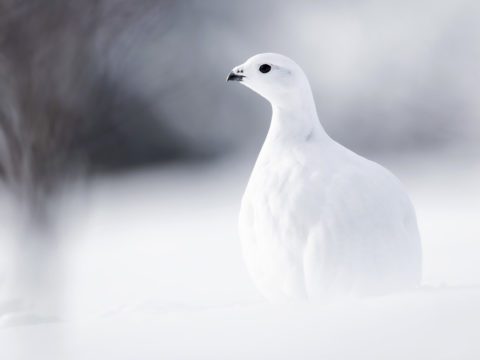Three Years After 3 Billion Birds Lost, America’s Birds Are Still in Decline
The latest State of the Birds Report uncovers continuing declines but also shows opportunities for bringing birds back—while aligning bird conservation with biodiversity protection, environmental justice, and climate resilience.
December 22, 2022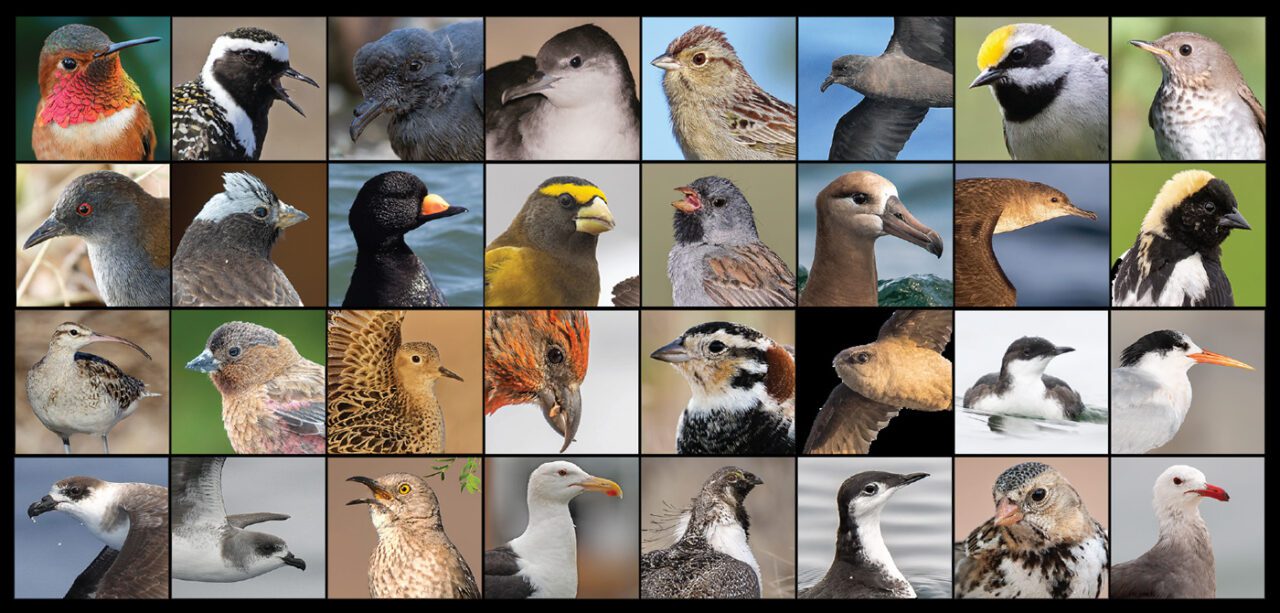
From the Winter 2023 issue of Living Bird magazine. Subscribe now.
Almost exactly three years after research published in the journal Science showed that North America had lost 3 billion breeding birds since 1970 (see Vanishing, Autumn 2019), the 2022 State of the Birds Report for the United States found that bird declines are continuing in almost every habitat, except wetlands—a finding that could provide a strategy for improving outcomes for all birds.
The report, released on October 12, 2022, reveals that bird populations in forests, grasslands, deserts, and oceans are struggling.
“The rapid declines in birds signal the intensifying stresses that wildlife and people alike are experiencing around the world because of habitat loss, environmental degradation, and extreme climate events,” said Amanda Rodewald, director of the Cornell Lab of Ornithology’s Center for Avian Population Studies and a co-chair of the State of the Birds science committee. “Taking action to bring birds back delivers a cascade of benefits that improve climate resilience and quality of life for people.”
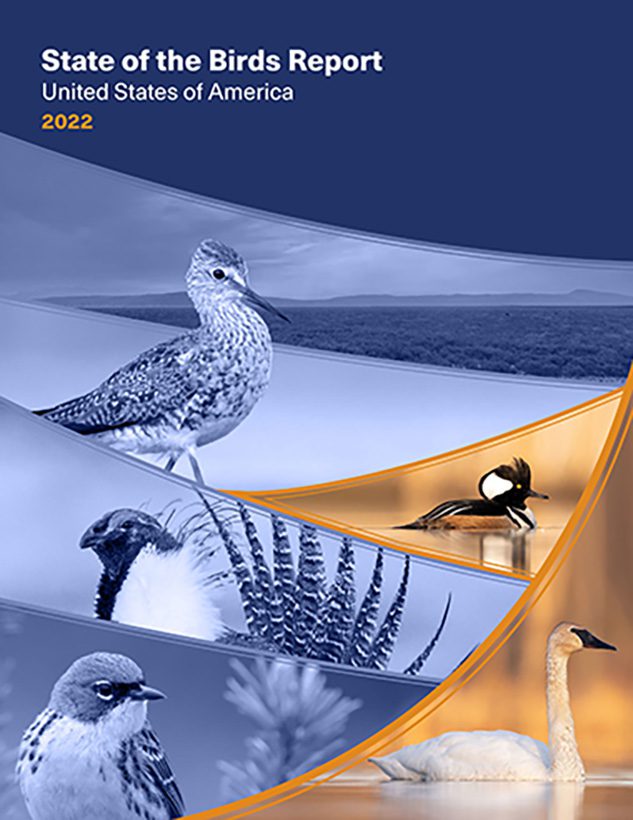
In addition to giving updates on bird population trends, the report also showed how conservation strategies to bring birds back can align with national priorities for broader biodiversity protection, environmental justice, and climate resilience. For example, fully implementing the habitat restoration plans in four Migratory Bird Joint Venture initiatives—in the Appalachian Mountains, Lower Mississippi River Bottomland Forests, Prairie Pothole Region, and river corridors in California’s Central Valley—would boost those habitats’ combined carbon sequestration capacity by more than 80 million metric tons of carbon over two decades, enough to offset the emissions from every registered vehicle in New York City over that timeframe. The report also spotlighted urban heat islands in the Houston area that could be greened up with tree planting in partnership with the federal Urban Bird Treaty program, thereby providing shade and cooling relief to inner-city residents while also creating stopover migratory habitat for the billions of birds that migrate along the Gulf Coast in spring and fall.
“Birds are environmental justice multipliers,” said Corina Newsome, associate conservation scientist at the National Wildlife Federation. “Migratory birds connect landscapes, spending part of the year in their breeding range, and during migration flying through a diversity of urban environments, including those that are disproportionately where Black and Brown communities are overburdened by environmental injustice. When we invest in bird conservation in those areas, we ensure that people as well as birds can thrive together.”
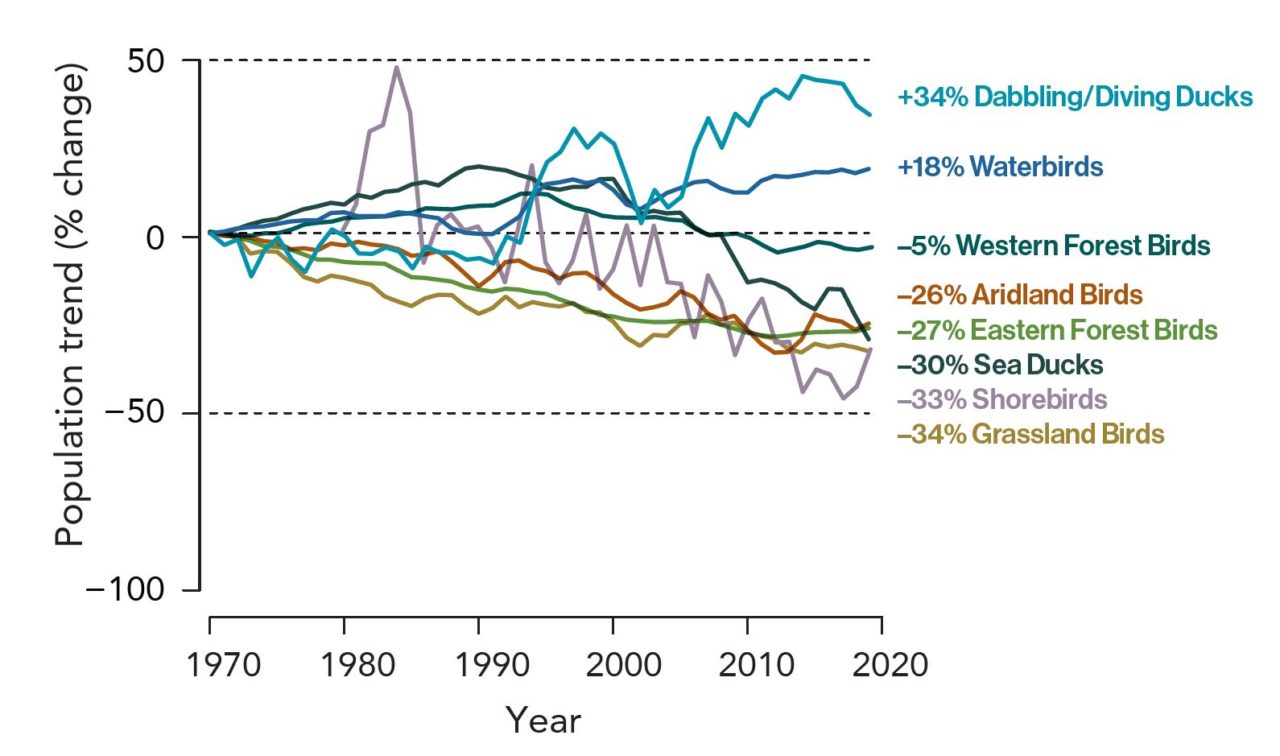
The 2022 report was published by the North American Bird Conservation Initiative, a forum of 33 leading government agencies and science and conservation organizations, including the Cornell Lab, National Wildlife Federation, U.S. Fish and Wildlife Service, Audubon, American Bird Conservancy, and Ducks Unlimited. It’s the ninth such U.S. State of the Birds Report published since 2009.
New in this 2022 edition of the report is a listing of 70 newly identified Tipping Point species—birds that are not currently protected under the Endangered Species Act, have lost 50% or more of their populations in the past 50 years, and are on a track to lose another half of their remnant populations in the next 50 years if nothing changes. The grim list of fast-declining species includes grassland birds such as Bobolink, forest birds such as Bicknell’s Thrush and Pinyon Jay, shorebirds such as Whimbrel, and seabirds such as Laysan Albatross. Proactive conservation efforts to help these birds before they require ESA protection is the fastest, most effective way to bring birds back, according to the report.
“What we’ve outlined in this State of the Birds Report is a recipe for how conservation biologists can work with communities and use surgical precision to solve environmental problems—blending new technology and data to pinpoint the cause of losses and to reverse declines while we still have the best chance … before more birds plummet to endangered,” said Peter Marra, director of Georgetown University’s Institute for Environment and Sustainability.
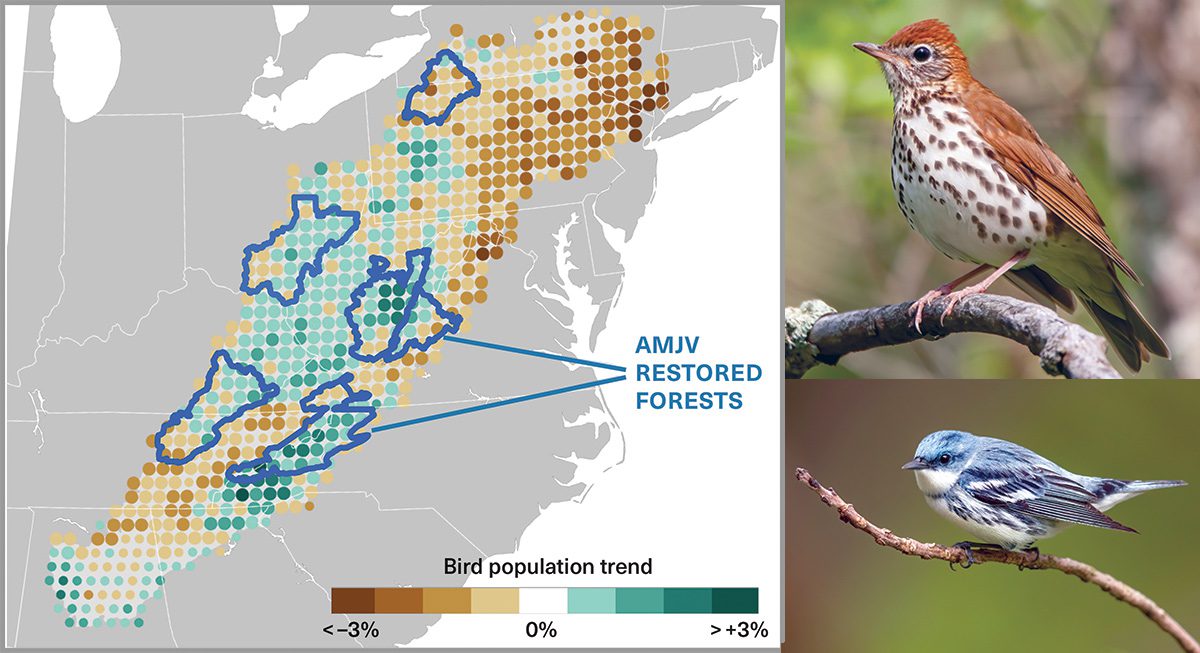
The positive trends for wetland-dependent species offer a silver lining in the report and a possible formula for helping birds and ecosystems rebound, say the report authors. Populations of waterbirds such as Roseate Spoonbill and Great Egret, and waterfowl such as Ring-necked and Wood Duck, have increased by 18% and 34%, respectively, since 1970.
“While a majority of bird species are declining, many waterbird populations remain healthy, thanks to decades of collaborative investments from hunters, landowners, state and federal agencies, and corporations,” said Karen Waldrop, chief conservation officer for Ducks Unlimited. “This is good news not only for birds, but for the thousands of other species that rely on wetlands, and the communities that benefit from groundwater recharge, carbon sequestration, and flood protection.”
Despite their long-term upward trend, duck populations ticked down slightly in the last few years, which the report’s scientists say is attributable to recent droughts along with pressures from grassland habitat loss and wetland drainage. That’s a warning, they say, to keeping applying the historic winning formula for waterfowl in wetlands as well as other habitats to help all birds and ecosystems rebound.
“The North American Waterfowl Management Plan, federal Duck Stamp Program, grants from the North American Wetlands Conservation Act, and regional Joint Ventures partnerships are all part of a framework that has a proven track record with restoring and protecting wetland-dependent species,” said Martha Williams, director of the U.S. Fish and Wildlife Service. “Now we want to use that precedent to work with our partners to restore bird populations, conserve habitat, and build a foundation for how we respond to the loss of other bird groups.”
Gallery: All 70 Tipping Point Species
The 2022 State of the Birds Report identified 70 Tipping Point species—birds that have lost half or more of their populations in the past 50 years and are on track to lose another half of their remaining populations in the next 50 years, unless something changes. All photos from Macaulay Library.
American Golden-Plover by Ian Davies
Ashy Storm-Petrel by Lexie Roberts
Audubon’s Shearwater by Ragupathy Kannan
Bachman’s Sparrow by Howard West
Band-rumped Storm-Petrel by Kate Sutherland
Bendire’s Thrasher by Derek Hameister
Bicknell’s Thrush by David Turgeon
Black Rail by Will Sweet
Black Rosy-Finch by Bryan Calk
Black Scoter by Matthew Sabatine
Black-capped Petrel by Kate Sutherland
Black-chinned Sparrow by Sharif Uddin
Black-footed Albatross by Mason Maron
Black-vented Shearwater by Ryan Sanderson
Bobolink by Dorian Anderson
Bristle-thighed Curlew by Pio Marshall
Brown-capped Rosy-Finch by Bryan Calk
Buff-breasted Sandpiper by Ian Davies
Cassia Crossbill by Kirk Gardner
Chestnut-collared Longspur by Derek Hameister
Chimney Swift by Ryan Sanderson
Craveri’s Murrelet by Thomas Ford-Hutchinson
Elegant Tern by Ben Lucking
Evening Grosbeak by Ryan Sanderson
Fea’s Petrel by Kate Sutherland
Golden-winged Warbler by Kevin Pero
Great Black-backed Gull by Andrew Simon
Greater Sage-Grouse by Darren Clark
Guadalupe Murrelet by Mel Senac
Harris’s Sparrow by Derek Hameister
Heermann’s Gull by BAL Land
Henslow’s Sparrow by Ryan Sanderson
Hudsonian Godwit by Anonymous
Ivory Gull by Peter Trimble
King Eider by Marco Valentini
King Rail by Stephen Hurst
Kittlitz’s Murrelet by Thomas Kallmeyer
Laysan Albatross by Fernando Medrano Martínez
Least Tern by Ian Davies
LeConte’s Sparrow by Sean Cowden
LeConte’s Thrasher by Brian Sullivan
Lesser Prairie-Chicken by Mouser Williams
Lesser Yellowlegs by Brad Imhoff
Mottled Duck by Andy Wilson
Mountain Plover by Brendan Galvin
Murphy’s Petrel by Josep del Hoyo
Parkinson’s Petrel by Gus Daly
Pectoral Sandpiper by Logan Lalonde
Pinyon Jay by Jim Merritt
Prairie Warbler by Ryan Sanderson
Red-faced Cormorant by Lars Petersson
Red-legged Kittiwake by Scott Schuette
Ruddy Turnstone by Natthaphat Chotjuckdikul
Rufous Hummingbird by Ryan Sanderson
Saltmarsh Sparrow by Bill Elrick
Scripps’s Murrelet by David Pereksta
Seaside Sparrow by Keenan Yakola
Semipalmated Sandpiper by Brad Vissia
Short-billed Dowitcher by Dorian Anderson
Sprague’s Pipit by David M. Bell
Stilt Sandpiper by Caroline Lambert
Townsend’s Storm-Petrel by Fernando Medrano Martínez
Tricolored Blackbird by David Yeamans
Wandering Tattler by Derek Hameister
Whimbrel by Brett Hoffman
Whiskered Auklet by McKenzie Mudge
Yellow Rail by Marky Mutchler
Yellow-billed Loon by Dubi Shapiro
Yellow-billed Magpie by Mason Maron
Krishna Ramanujan is a senior staff writer at the Cornell Chronicle who covers life sciences, agriculture, and veterinary medicine.

All About Birds
is a free resource
Available for everyone,
funded by donors like you
American Kestrel by Blair Dudeck / Macaulay Library
